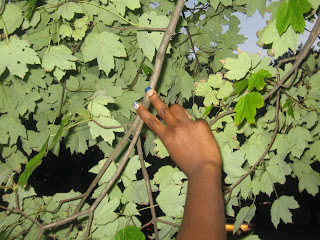Please use this blog to post your biology collections. Collections should be compiled into two (2) separate blog posts. Please be sure to include a recurring object for each of the images. For example, feel free to include a pair of keys, a pen, pencil or any other object so that I can be confident that your images were original. Feel free to view the examples posted below. Should you need to contact me, feel free to do so at dawn.berkeley@pgcps.org and I should be able to respond to your inquiry within 2 business days.
Thanks and I am looking forward to a dynamic year!
Cheers!
Dawn Berkeley
THE BIO BUZZ 2011 - 2012
Friday, June 17, 2011
Sunday, November 1, 2009
A.G - Biology Collection 2
An herbaceous stem is the stem of plant that dies down to its roots every year during cold climates. In warmer climates an herbaceous stem may grow all year. This plant stem is herbaceous because it contains no woody tissue.
_________________________________
2. Fruit - Fleshy with Seed
A fleshy fruit with seeds has a fleshy fruit that protects the seeds that create new trees. The fruit is the matured ovary of the pistil of a flower. This apple is a fleshy fruit with seeds inside.
________________________________
Bryophytes are non-vascular plants that have tissues, an enclosed reproductive system, and reproduce through spores. The moss on the side of this tree is an example of bryophyte.
_________________________________
Keratin is a family of hard, structural, tough, and insoluble proteins that form hard structures in many kinds of animals. Hair is an example of keratin.
______________________________
Reptiles were the first to develop amniotic eggs. These eggs were shelled, meaning that unlike the shell-less eggs of their predecessors, amphibians, they could be laid away from water. These eggs are an evolutionary advantage for reptiles, egglaying mammals and birds. This chicken egg is amniotic.
___________________________
6. Long-day Plant
This clover is an example of a long-day plant. A clover is a long-day plant because it requires less than 18 hours of darkness in every 24 hours to cause flowering.
________________________________
Epithelial tissue covers the whole surface of the body. It is made up of cells closely packed and ranged in one or more layers.Epithelial tissue that occurs on surfaces on the interior of the body is known as endothelium. The skin on our hands is an example of Epithelial Tissue.
_________________________________
to modify means to change in form or character; alter.The leaves of this plant have been modified. Some have been bitten into and others have changed colors.
__________________________________
9. Cellulose
Forms the main constituent of the cell wall in most plants. This Plant contains Cellulose
_________________________________
Plants have adaptations to help them survive (live and grow) in different areas. Adaptations are special features that allow a plant or animal to live in a particular place or habitat. This plant is able to grow and survive because of it's adaptation to the surrounding area.
____________________________
Alicia Giles - Biology Collection 1
1. Deciduous Leaves.
Deciduous means falling off at maturity or tending to fall off & is typically used in reference to trees or shrubs that lose their leaves seasonally and the shedding of other plant structures such as petals after flowering or fruit when ripe. In short deciduous means the dropping of a part that is no longer needed, as these leaves shown here were.
______________________________
The female cone contains ovules within which, when fertilized by pollen (which is produced by the male cones), become seeds. Lack of pollination, genetic defects or other mishaps may result in sterile, or no, seeds. The female pine cone is very different from the male because it forms at the top of the tree and is much larger in size than the male cone.
______________________________
The ovary of a flower is the part of the carpel that holds the ovules of a plant and is the female reproductive organ. The ovary of this flower is located in the center where the yellow part of it is visible.
______________________________
A woody stem is a stem that is hard textured and has a secondary xylem. Generally a plant with a woody stem has been growing for two years and has an enlarged stem to accommodate greater circulation. These tree trunks are woody stems because of their texture and the age of the trees.
__________________________________
5. Conifer Leaves
Conifer leaves are small, narrow, and have a thick surface, to limit transpiration, or water loss. These pine tree leaves are considered to be conifer leaves. Leaves of evergreen trees are also conifer leaves. Other characteristics of conifer leaves is that they can survive weather changes, as well as extreme weather unlike the decidious leaves of regular trees & plants.
_______________________________
The cuticle layer of a plant is a non-cellular protective layer that protects the epidermis of the green parts of leaves. It also provides support for the plants much like human skin does. The coating of the leaf in this picture, which makes it shine, is the cuticle layer of the plant.
____________________________________
An angiosperm is a flowering plant that reproduces through the transfer of pollen. This plant is an angiosperm because it has flowers.
__________________________________
An autotroph is an organism that takes energy from the environment in the form of sunlight or inorganic chemicals and uses it to create molecules such as carbohydrates. This makes them primary producers. This plant is an autotroph because it takes energy from sunlight through photosynthesis and produces carbohydrates.
________________________________
An endotherm is an organism that is warm-blooded, and therefore maintains a roughly constant body heat regardless of outside temperature. Most endotherms control body heat by regulating their metabolic rates. This dog is a mammal, and is therefore an endotherm.
__________________________________
The Vascular Tissue of a Plant consists of xylem and phloem. These two types of vessels run side-by-side, extending from roots to leaves. They provide channels for the transport of water and nutrients. This plant contains herbaceous stems which have vascular tissue.
________________________________
Wednesday, September 16, 2009
Jeni Huezo notes on video
1: There are differences in the chemical make-up of organic and inorganic substances.
2: Organic matter are considered to be living substances.
3: Carbon is the foundation of molecular structures for all living things.
4: Carbon has an incredible ability to combine with other elements.
5: Carbon is found everywhere, forming short, strong, and stable covalent bonds.
6: Hydrocarbons are called fossil fuels.
7: Alkanes have the general formula of CnH2n+2.
8: Unsaturated hydrocarbons are not filled to capacity with hydrogen atoms.
9:Hydroxyl's end with suffix of "ol."
10: When oxygen is attached to a carbon by double covalent bonds, it is a carbonyl group.
Sunday, August 30, 2009
The Six Kingdoms
What I've learned on the six kingdoms is that they are placed into their kingdoms by a specific way. It depends on their cell type, their ability to make food, and the number of cells in their body. Also when this system of different kingdoms was being developed by Linnaeus it only contain two kingdoms which were Plants and Animals. What contributed to the being of six Kingdoms was the heavy use of the microscope. One cool thing I did not know before looking on this website was that Yellowstone National park was the first place Archaebacteria were discovered.
Here is the Link
http://www.ric.edu/faculty/ptiskus/Six_Kingdoms/Index.htm
Here is the Link
http://www.ric.edu/faculty/ptiskus/Six_Kingdoms/Index.htm
Tuesday, August 25, 2009
Monday, August 24, 2009
10 collection items for Aug24th
 Pollen: Fine to coarse powder which produce male gametes of seed plants.
Pollen: Fine to coarse powder which produce male gametes of seed plants. Dicot plant with flower and leaf: Is a name for a group of flowering plants whose seed has two embryonic leaves or cotyledons; they also have veins. This leaf has major leaf veins.
Dicot plant with flower and leaf: Is a name for a group of flowering plants whose seed has two embryonic leaves or cotyledons; they also have veins. This leaf has major leaf veins. Protein-fibrous: Is insoluble and strong that plays a structural role in organisms for support or protection. The keratin in the hair is a fibrous protein.
Protein-fibrous: Is insoluble and strong that plays a structural role in organisms for support or protection. The keratin in the hair is a fibrous protein. Niche: Is a place for where a thing is best fitted. The nest is necessary for existence
Niche: Is a place for where a thing is best fitted. The nest is necessary for existence Pine cone-female: Produces the ovule and forms at the top of the tree compared to the male cone.
Pine cone-female: Produces the ovule and forms at the top of the tree compared to the male cone. Keratin: Is a very strong protein which is a major component in the skin, hair, nails etc. In the dogs paws, skin the protein is present.
Keratin: Is a very strong protein which is a major component in the skin, hair, nails etc. In the dogs paws, skin the protein is present. Amylase: It breaks down starch into sugar. Human saliva where it begins the the process of digestion.
Amylase: It breaks down starch into sugar. Human saliva where it begins the the process of digestion. Amniotic egg: The type of egg produced by reptiles, birds and egg laying mammals in which the embryo develops inside an amnion.
Amniotic egg: The type of egg produced by reptiles, birds and egg laying mammals in which the embryo develops inside an amnion.  lipid used for energy storage: Lipids are natural organic molecules which includes fats, waxes and sterols. Chicken contains fats and oils
lipid used for energy storage: Lipids are natural organic molecules which includes fats, waxes and sterols. Chicken contains fats and oils Protein-globular: Are highly soluble and play a dynamic role in body metabolism. This protein is abundant in animal cells and milk which is shown in this picture.
Protein-globular: Are highly soluble and play a dynamic role in body metabolism. This protein is abundant in animal cells and milk which is shown in this picture.
Biology Collection 2

This is a picture of a female pine cone. This pine cone is smaller then most pine cones which means that it is a female pine cone.

This picture represents a deciduous leaf. This leaf fell off a tree before turning the right color therefore it is a deciduous leaf.

This is a picture of my baby cousin who represents endotherm. She is a representation of endotherm because she is an organism that generates heat in order to maintain her body temperature and live in the environment around her.

This is a picture of an adaptation of a plant. The branches that are branching out in different directions are adapted by the plant in order to grow and live in the condtions of the environment.

This is a picture of a leaf-gymnosperm. This is an evergreen that has lasted more than one growing cycle which makes it a gymnosperm leaf.

This picture represents vascular plant tissue. When you rip the plant leaf down the middle you can see cross sections which are the vascular bundles. The vascular bundles have xylem and phloem.

This picture represents protein-fibrous. The tree is insoluble and strong and has support and protection.

This picture represents a stem that is woody. The thickness of the stem shows that the stem has been growing for 2 or more years so it becomes a woody stem.

This picture represents pollen. The fine dust that is in the middle of the plant that is microspores in the plant.

This is a picture representing a stem-herbacious. The stem has no woody tissue and it has a longer tip because the cells are dividing in the apical merisetm.
Natalie's Biology Collection 2
Subscribe to:
Comments (Atom)

















